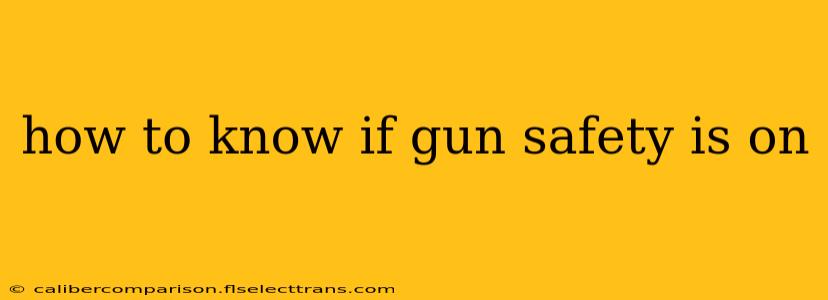Gun safety is paramount. Knowing definitively whether your firearm's safety is engaged is not just important—it's crucial for preventing accidents. This guide will cover various safety mechanisms, how to check them, and what to do if you're unsure. Remember, treating every firearm as if it were loaded is the single most important rule of gun safety.
Understanding Different Safety Mechanisms
Firearms utilize various safety mechanisms, and understanding their specific operation is vital. These include:
-
Manual Safeties: These are typically levers or switches that physically block the firing mechanism. They're often located on the receiver, slide, or frame of the gun. Positions usually include "on" (safe) and "off" (fire). Some have a third position, such as a "half-cock" position on older designs.
-
Grip Safeties: These are activated by the proper grip on the firearm. Incorrect grip will prevent the gun from firing.
-
Trigger Safeties: These are built into the trigger mechanism itself, preventing the gun from firing unless the safety is disengaged and the trigger is pulled correctly.
-
Firing Pin Block Safeties: These are internal mechanisms that prevent the firing pin from striking the cartridge primer unless the trigger is fully depressed and other safety mechanisms are disengaged. These are often passive safeties, meaning they are always engaged unless the trigger is actively pulled.
How to Check if Your Gun's Safety is On
The method for checking your firearm's safety depends entirely on the type of firearm and its safety mechanism. Always consult your firearm's owner's manual. This is the definitive source for understanding your specific gun's safety features.
General Steps (Adapt to your specific firearm):
-
Visual Inspection: Carefully examine the safety mechanism. Look for visual indicators, such as a lever in the "safe" position, a clearly marked "safe" indicator, or a visible block preventing the trigger from being depressed.
-
Physical Check: Gently manipulate the safety lever (if applicable). Does it move freely? Is there any resistance indicating it's engaged?
-
Dry Fire (Only with an unloaded firearm and in a safe environment): If your firearm's manual permits, cautiously attempt to dry fire (pull the trigger without ammunition). If the safety is engaged, the trigger should not release the firing pin. Never dry fire a firearm without explicitly confirming it is unloaded.
-
Professional Inspection: If you are ever unsure about the status of your firearm's safety, seek guidance from a qualified gunsmith or firearms instructor. They can provide personalized instruction and ensure your understanding of your weapon's safety features.
What to Do if You're Unsure
If you are ever unsure whether your firearm's safety is engaged, treat the weapon as if it were loaded. Follow these steps:
-
Point the firearm in a safe direction: This means pointing the muzzle downrange, away from people and objects.
-
Keep your finger off the trigger: Maintain a firm grip, but keep your finger away from the trigger until you're absolutely certain it's safe.
-
Visually and physically check the safety: Carefully re-examine the safety mechanism using the steps outlined above.
-
Unload the firearm: If you still have any doubts, immediately unload the firearm and store it safely, separated from ammunition.
Emphasizing Safe Gun Handling Practices
This guide offers information on checking gun safety, but it's not a replacement for proper firearms training. Always prioritize safe gun handling practices, including:
- Never point a firearm at anything you don't intend to shoot.
- Keep your finger off the trigger until ready to shoot.
- Be sure of your target and what's beyond it.
- Store firearms safely and securely.
- Regularly clean and maintain your firearm.
- Seek professional training from qualified instructors.
By understanding your firearm's safety mechanisms and following safe handling procedures, you significantly reduce the risk of accidents. Remember, responsible gun ownership includes continuous learning and a commitment to safety.

